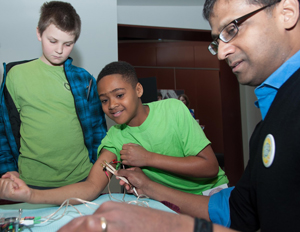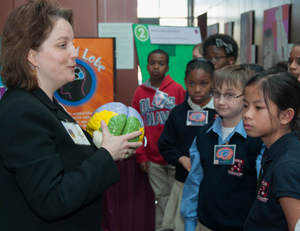Archived Content
The National Institute of Mental Health archives materials that are over 4 years old and no longer being updated. The content on this page is provided for historical reference purposes only and may not reflect current knowledge or information.
Students Unlock the Mysteries of the Brain with NIH Scientists
• Press Release
Hundreds of middle school students from the Washington, D.C., area will visit the National Museum of Health and Medicine in Silver Spring, Md., this week for a special brain-bending experience. Alongside scientists from seven institutes of the National Institutes of Health, these students will become neuroscientists for a day as part of the 14th annual Brain Awareness Week celebration at the museum.
Brain Awareness Week (March 10 – 16) is an annual global public outreach partnership of government agencies, universities, hospitals, patient advocacy groups, scientific societies, service organizations, and schools. The event was started nearly two decades ago by the Dana Alliance for Brain Initiatives, a nonprofit organization of over 300 leading neuroscientists, as a campaign to increase public awareness of the progress and benefits of brain research.
“Brain Awareness Week is a great opportunity for young people to connect with NIH scientists and explore the human brain in a way that is truly hands-on,” said Thomas R. Insel, M.D., director of the National Institute of Mental Health (NIMH). “We hope to make this event a memorable experience that will inspire the next generation of brain pioneers.”
NIH activities will include:
- NIMH: See YOUR BRAIN in Action
Students will see how the brain and spinal cord work together to control emotions and physical well-being. They will observe recordings of the electrical activity generated by muscles in their own arms and fingers and gain a deeper understanding of the human nervous system. - National Eye Institute (NEI): More than Meets the Eye
Students will learn how the brain and eyes work together to help us see. NEI scientists will then share the science behind optical illusions to reveal how the complex circuitry in the brain can sometimes fool us into seeing things that are not really there. - National Institute on Aging (NIA): Mysteries of the Brain
Students will investigate how we learn about human brains. NIA scientists will show a video of mice performing a memory task and then engage students in a discussion of how the brain can benefit from a healthy diet, mental stimulation and exercise—some of the interventions being tested today as potential means to delay or prevent memory disorders. - National Institute on Alcohol Abuse and Alcoholism: Cool Spot Carnival
Students will explore how alcohol interferes with brain development, sensory perception, movement, and balance. They will learn that even though teens may not feel alcohol’s effects as immediately as do older individuals, alcohol still affects their functioning and can put them at serious risk. - Eunice Kennedy Shriver National Institute of Child Health and Human Development: Bionics: Creating the “Six Million Dollar Man”
Students will learn about the advancement of artificial limbs and assistive technology throughout history. They will interact with state of the art myoelectric control for prosthetic limbs and see how the power of the brain can be used to restore function to the human body after disease or injury. - National Institute on Drug Abuse: NIDA Brain Derby
Students will play an interactive computer-based game called Brain Derby. Teams of students will have the opportunity to earn Brain Scientist certificates by correctly answering questions related to how abused drugs act in the brain and body. - National Institute of Neurological Disorders and Stroke (NINDS): Brain Lobe-oratorium
Students will discover the unique features of each of the four lobes of the human brain by interacting with colorful life-size brain models. NINDS scientists will help students learn about how each lobe contributes to perception, thinking, personality and behavior.

A student observes the electrical activity generated by his muscles.
Source: National Museum of Health and Medicine

Students learn about brain anatomy.
Source: National Museum of Health and Medicine
About the National Institute of Mental Health (NIMH): The mission of the NIMH is to transform the understanding and treatment of mental illnesses through basic and clinical research, paving the way for prevention, recovery and cure. For more information, visit the NIMH website.
About the National Institutes of Health (NIH): NIH, the nation's medical research agency, includes 27 Institutes and Centers and is a component of the U.S. Department of Health and Human Services. NIH is the primary federal agency conducting and supporting basic, clinical, and translational medical research, and is investigating the causes, treatments, and cures for both common and rare diseases. For more information about NIH and its programs, visit the NIH website .
NIH…Turning Discovery Into Health®
